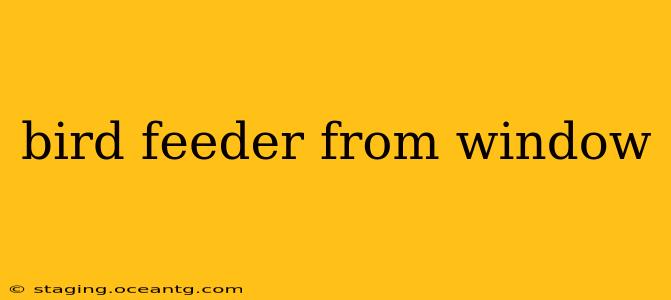Want to bring the beauty of nature right to your window? A window bird feeder offers unparalleled views of your avian visitors, transforming your home into a vibrant wildlife sanctuary. This comprehensive guide explores everything you need to know about choosing, installing, and maintaining the perfect window bird feeder, ensuring you enjoy a constant stream of feathered friends.
What are the Benefits of a Window Bird Feeder?
Window bird feeders offer a unique and rewarding experience. Instead of simply hearing birdsong, you get an up-close-and-personal view of their fascinating behaviors—from the intricate details of their feathers to their acrobatic feeding techniques. This proximity fosters a deeper appreciation for nature and offers fantastic opportunities for birdwatching, photography, and even educational moments for children. Plus, you get to enjoy the delightful entertainment of watching birds fight over sunflower seeds!
What Types of Window Bird Feeders are Available?
Several types of window bird feeders cater to different preferences and bird species.
Suction Cup Feeders:
These are the most common and easiest to install. Simply attach the feeder to a clean window with strong suction cups. They are ideal for smaller feeders and are generally inexpensive. However, they may not be suitable for larger, heavier feeders or areas with extreme temperature fluctuations.
Mounted Feeders:
These feeders attach directly to the window frame or outside wall using screws or brackets. They offer greater stability and can support larger feeders with more food capacity. This makes them a great choice for attracting a wide variety of birds.
Window Feeders with Perches:
These feeders incorporate perches, providing birds with a comfortable place to rest while they feed. This is particularly attractive to birds that prefer to feed while perched, such as finches and cardinals. However, these perches may also attract larger birds that could bully smaller ones.
Tube Feeders:
These are versatile options that often feature multiple feeding ports to accommodate multiple birds. Many are designed with clear tubes to allow for easy monitoring of food levels.
What Kind of Birdseed Should I Use?
The type of birdseed you use significantly impacts the types of birds attracted to your feeder. A mix of seeds caters to a wider range of species.
- Sunflower seeds: A favorite among many birds, offering high energy and nutritional value.
- Nyjer seeds (thistle): Attracts smaller birds like goldfinches and siskins.
- Milo: A less expensive option that attracts doves and sparrows.
- Suet: High in fat and calories, ideal for winter feeding.
- White-striped sunflower seeds: These are larger than black oil sunflower seeds and often preferred by larger birds.
Avoid using cracked corn or cheap mixes, which can attract unwanted pests and provide less nutritional value.
How Do I Clean My Window Bird Feeder?
Regular cleaning is essential to prevent the spread of disease among birds. Clean your feeder at least once a month, or more frequently during warm, humid weather. Use a mild soap solution and warm water, rinsing thoroughly before refilling. Allow the feeder to air dry completely before placing it back on your window.
How Do I Prevent Squirrels from Getting to My Window Bird Feeder?
Squirrels are notorious for raiding bird feeders. Consider using a squirrel-resistant feeder with baffles or cages to deter them from reaching the food. You can also strategically position your feeder to make access more difficult for squirrels.
What are Some Tips for Choosing the Right Location for My Window Bird Feeder?
- Choose a location with ample sunlight: Birds are more likely to visit feeders in sunny areas.
- Provide ample space around the feeder: Avoid placing the feeder too close to bushes or trees that could offer cover to predators.
- Keep the feeder away from potential hazards: Avoid areas with nearby windows or other potential hazards for the birds.
- Consider the height: Position the feeder at a height that makes it easily accessible to birds but difficult for cats or other predators.
Is it Safe for Birds to Feed Near Windows?
While window feeders provide excellent viewing opportunities, it's crucial to ensure the safety of your avian visitors. Use feeders designed to minimize collisions, and consider adding decals or window stickers to prevent birds from flying into the glass.
By following these tips, you can create a bird-friendly haven right outside your window, enjoying the beauty and wonder of nature up close.
